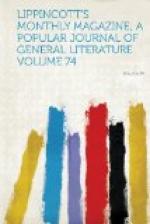The accumulated experience of past expositions, seconded by the judgment and systematic thoroughness apparent in the preparations for the present one, makes this a good “working” classification. It has done away with confusion to an extent hardly to have been hoped for, and all the thousands of objects and subjects have dropped into their places in the exhibition with the precision of machinery, little adapted as some of them are to such treatment. Very impalpable and elusive things had to submit themselves to inspection and analysis, and have their elements tabulated like a tax bill or a grocery account. All human concerns were called on to be listed on the muster-roll and stand shoulder to shoulder on the drill-ground. Some curious comrades appear side by side in the long line. For example, we read: Class 286, brushes; 295, sleighs; 300, elementary instruction; 301, academies and high schools, colleges and universities; 305, libraries, history, etc.; 306, school-books, general and miscellaneous literature, encyclopaedias, newspapers; 311, learned and scientific associations, artistic, biological, zoological and medical schools, astronomical observatories; 313, music and the drama. Then we find, closely sandwiched between, 335—topographical maps, etc.—and 400—figures in stone, metal, clay or plaster—340, physical development and condition (of the young of the genus Homo); 345, government and law; 346, benevolence, beginning with hospitals of all kinds and ending with—in the order we give them—emigrant-aid societies, treatment of aborigines and prevention of cruelty to animals! In the last-named subdivision the visitor will be stared out of countenance by Mr. Bergh’s tremendous exposure of “various instruments used by persons in breaking the law relative to cruelty to animals,” the glittering banner of the S.P.C.A., and its big trophy, eight yards square, that illuminates the east end of the north avenue of the Main Building, in opposition to the trophy at the other end of the same avenue illustrating the history of the American flag. But he will look in vain for selected specimens of the emigrant-runner, the luxuries of the steerage and Castle Garden, or for photographs of the well-fed post-trader and Indian agent, agricultural products from Captain Jack’s lava-bed reservation and jars of semi-putrescent treaty-beef. He will alight, next door to the penniless immigrant, the red man and the omnibus-horse, on Class 348, religious organizations and systems, embracing everything that grows out of man’s sense of responsibility to his Maker. It will perhaps occur to the observer that, though the juxtaposition is well enough, religion ought to have come in a little before. His surprise at the power of condensation shown in compressing eternity into a single class will not be lessened when he passes on to Class 632, sheep; 634, swine; and 636, dogs and cats!




